Detailed Report on Cyber Security Strategies, Policies, and Tools
VerifiedAdded on 2023/06/11
|10
|1480
|414
Report
AI Summary
This report provides a comprehensive overview of cyber security strategies and policies essential for organizational protection. It begins by highlighting the importance of security awareness and training programs to reduce cyber security risks through employee education. The report details the creation and enforcement of cyber security policies, including access control and data encryption, to mitigate internal and external threats. It further discusses intrusion detection and prevention tools and techniques, emphasizing the use of systems like Snort to identify and block malicious activity. Vulnerability assessment and penetration testing procedures are explored as methods to proactively identify and address system weaknesses. The report also outlines the critical components of a disaster recovery program, focusing on data backup and the implementation of firewalls and strict access controls. Finally, it explains the Defence in Depth principle, which integrates physical, technical, and administrative controls to ensure robust security across the entire system.

Cyber Security
Paraphrase This Document
Need a fresh take? Get an instant paraphrase of this document with our AI Paraphraser
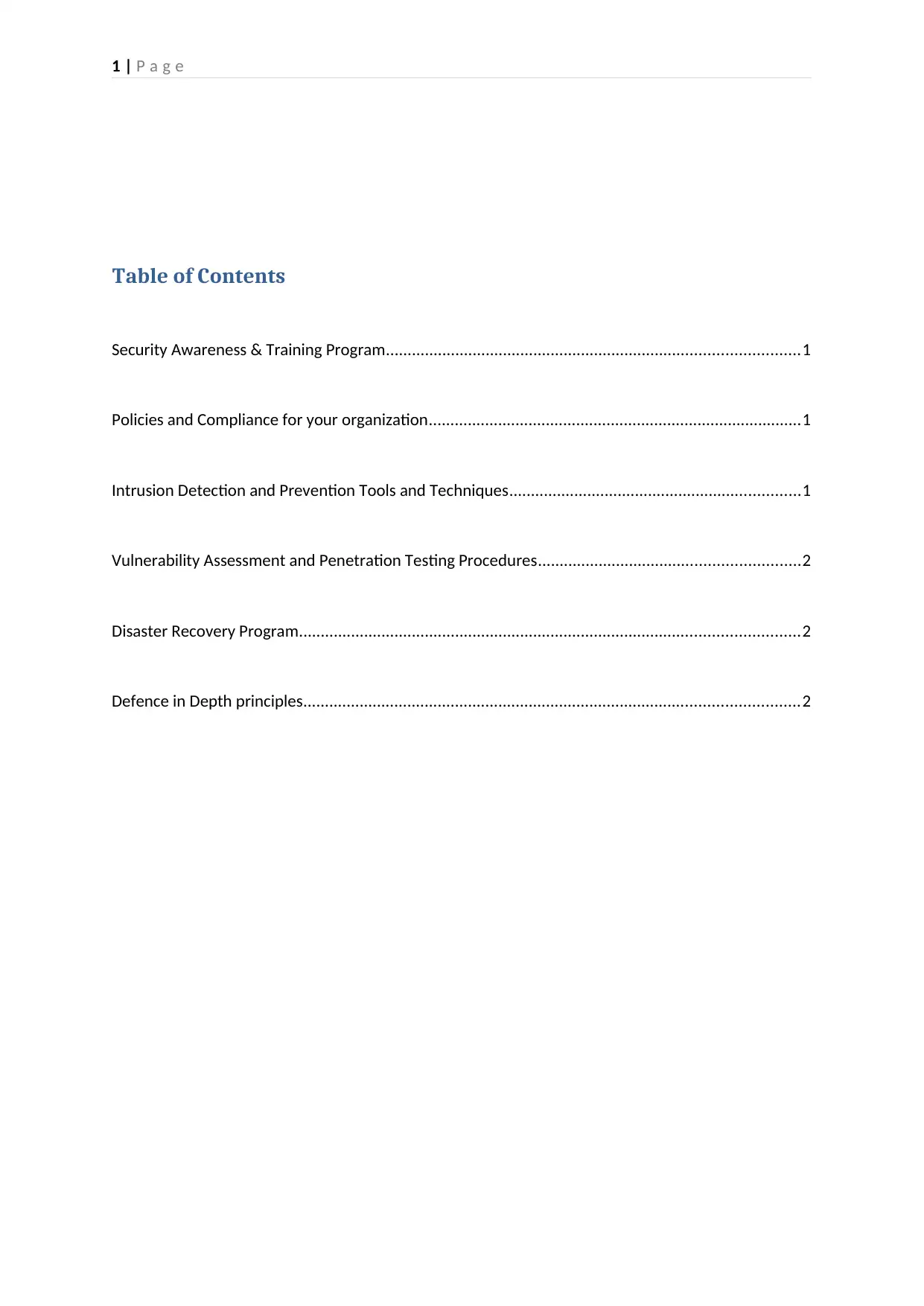
1 | P a g e
Table of Contents
Security Awareness & Training Program...............................................................................................1
Policies and Compliance for your organization......................................................................................1
Intrusion Detection and Prevention Tools and Techniques...................................................................1
Vulnerability Assessment and Penetration Testing Procedures............................................................2
Disaster Recovery Program...................................................................................................................2
Defence in Depth principles..................................................................................................................2
Table of Contents
Security Awareness & Training Program...............................................................................................1
Policies and Compliance for your organization......................................................................................1
Intrusion Detection and Prevention Tools and Techniques...................................................................1
Vulnerability Assessment and Penetration Testing Procedures............................................................2
Disaster Recovery Program...................................................................................................................2
Defence in Depth principles..................................................................................................................2

2 | P a g e
Security Awareness & Training Program
Being cyber security director various training programs and security awareness is
created. They launch awareness so that it reduces the risk of cyber security. Thus training is
provided so that they can overcome all the security issues. Security awareness programs are
important as they reinforce security and responsibility in the company. Training programs are
organised in an organisation which tells about all kind of attacks so that at time of security
breach they could take proper steps (Abrams & Weiss, 2018). Security awareness is done by
communicating all the concept of cyber security among employees. For spreading awareness
a security handbook is shared among all the employees and training programs are helpful for
both new hires as well as on-going employees. Security awareness and training programs
guarantees that security control and steps are decided. The benefits of cyber security
awareness and training help in exposure to cyber security risks. They also lower the
frequency of cyber related attacks and also save the times by possibly finding all the flaws.
The training program covers the organisational policies, culture, procedures and threats. The
training session covers new threats and involves all the business culture.
Security Awareness & Training Program
Being cyber security director various training programs and security awareness is
created. They launch awareness so that it reduces the risk of cyber security. Thus training is
provided so that they can overcome all the security issues. Security awareness programs are
important as they reinforce security and responsibility in the company. Training programs are
organised in an organisation which tells about all kind of attacks so that at time of security
breach they could take proper steps (Abrams & Weiss, 2018). Security awareness is done by
communicating all the concept of cyber security among employees. For spreading awareness
a security handbook is shared among all the employees and training programs are helpful for
both new hires as well as on-going employees. Security awareness and training programs
guarantees that security control and steps are decided. The benefits of cyber security
awareness and training help in exposure to cyber security risks. They also lower the
frequency of cyber related attacks and also save the times by possibly finding all the flaws.
The training program covers the organisational policies, culture, procedures and threats. The
training session covers new threats and involves all the business culture.
⊘ This is a preview!⊘
Do you want full access?
Subscribe today to unlock all pages.

Trusted by 1+ million students worldwide

3 | P a g e
Policies and Compliance for your organization
There are various security threats due to cyber-crimes. Thus as a director various
policies are designed that covers providing appropriate rights to the employees about who can
read, write and modify the system. The access is limited to only valid users. The policies
cover the details regarding who can access the system. There are viruses and attacks that
weakness the security of the network thus encryption of data is done (Todev, 2015). The
information is encrypted so that even if hackers or third party access the data they cannot read
the actual data.
Cyber security policies are a set of rules and regulations that are designed for an
organisation so that security breach does not occur within an organization. These policies
basically determine who is responsible to access the data. The policies include updating the
software’s and implements security audits for the management. The policies states that
regular data backups need to done so that at time of security breaches it do not cause loss to
an organisation.
Policies and Compliance for your organization
There are various security threats due to cyber-crimes. Thus as a director various
policies are designed that covers providing appropriate rights to the employees about who can
read, write and modify the system. The access is limited to only valid users. The policies
cover the details regarding who can access the system. There are viruses and attacks that
weakness the security of the network thus encryption of data is done (Todev, 2015). The
information is encrypted so that even if hackers or third party access the data they cannot read
the actual data.
Cyber security policies are a set of rules and regulations that are designed for an
organisation so that security breach does not occur within an organization. These policies
basically determine who is responsible to access the data. The policies include updating the
software’s and implements security audits for the management. The policies states that
regular data backups need to done so that at time of security breaches it do not cause loss to
an organisation.
Paraphrase This Document
Need a fresh take? Get an instant paraphrase of this document with our AI Paraphraser

4 | P a g e
Intrusion Detection and Prevention Tools and Techniques
An intrusion is a bug that soils the confidentiality, integrity and availability of a
network. Thus it is important to monitor these events so that it does not allow access to
resource by unauthorised users. For this intrusion detection technique is used to be aware
about all the intrusion that penetrates in the network by taking predefined actions like
blocking of IP addresses. The detection system is used to keep an eagle eye on the system.
Intrusion Detection in a system is the main part as it identifies the incorrect behaviour in the
system caused by attack (Ashfaq, Wang, Huang, Abbas & He, 2017). It is software that uses
a signature list of possible malware and designs policies to give alert regarding an attack. It
creates signature list of threats and compares it with any upcoming malware on the network,
so that abnormalities don’t penetrate in the system. It helps in organizing and understanding
the aim of security and control measures.
It also checks the network traffic and trails that network that is not misused or
accessed by third party. It aims in catching the attacker before it cause real damage on the
network. Among various network intrusion detection technique, Snot is commonly used
intrusion detection system. It is available for free ad helps in detecting threats. It provides
user friendly interface for managing security issues.
Intrusion Detection and Prevention Tools and Techniques
An intrusion is a bug that soils the confidentiality, integrity and availability of a
network. Thus it is important to monitor these events so that it does not allow access to
resource by unauthorised users. For this intrusion detection technique is used to be aware
about all the intrusion that penetrates in the network by taking predefined actions like
blocking of IP addresses. The detection system is used to keep an eagle eye on the system.
Intrusion Detection in a system is the main part as it identifies the incorrect behaviour in the
system caused by attack (Ashfaq, Wang, Huang, Abbas & He, 2017). It is software that uses
a signature list of possible malware and designs policies to give alert regarding an attack. It
creates signature list of threats and compares it with any upcoming malware on the network,
so that abnormalities don’t penetrate in the system. It helps in organizing and understanding
the aim of security and control measures.
It also checks the network traffic and trails that network that is not misused or
accessed by third party. It aims in catching the attacker before it cause real damage on the
network. Among various network intrusion detection technique, Snot is commonly used
intrusion detection system. It is available for free ad helps in detecting threats. It provides
user friendly interface for managing security issues.
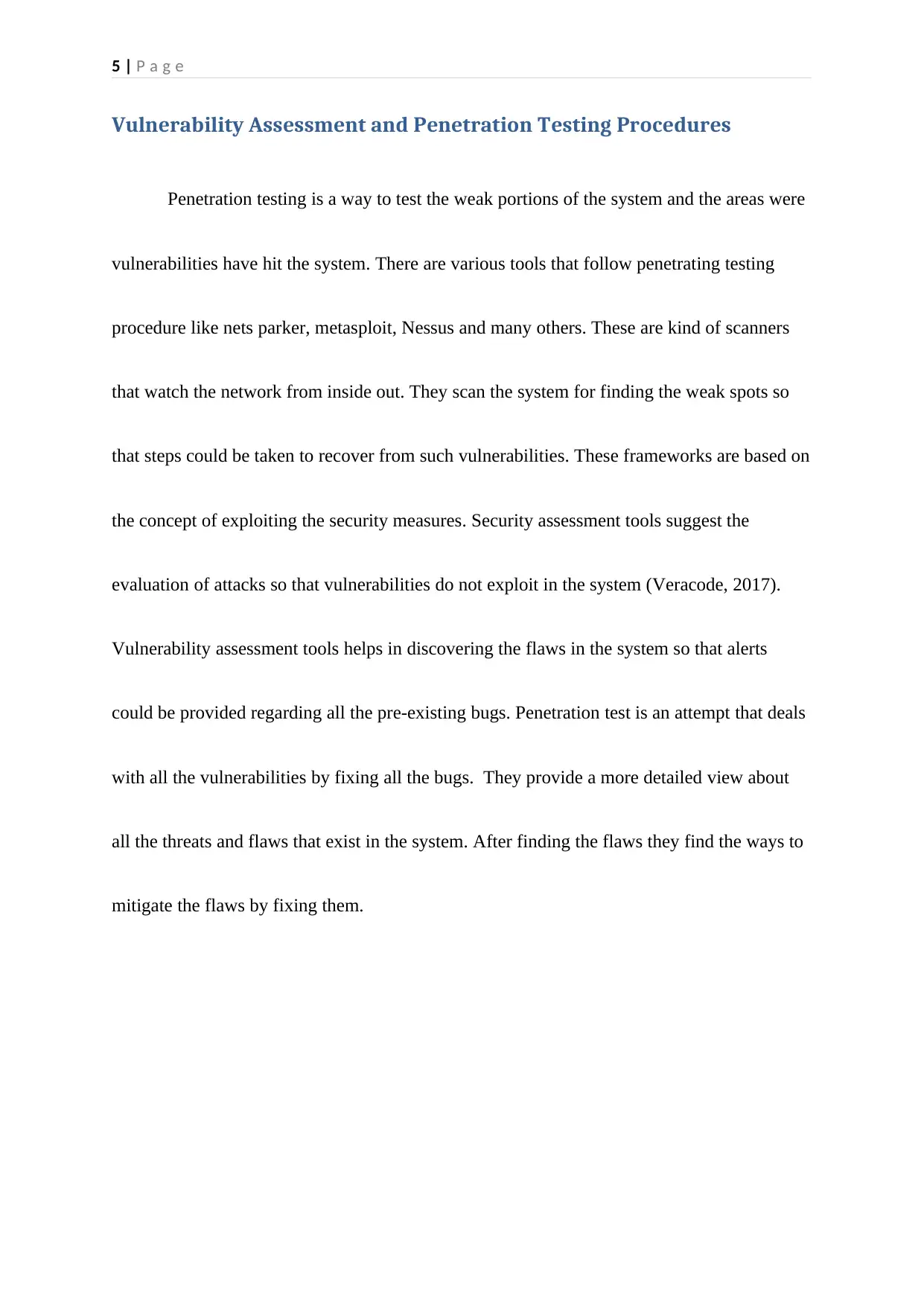
5 | P a g e
Vulnerability Assessment and Penetration Testing Procedures
Penetration testing is a way to test the weak portions of the system and the areas were
vulnerabilities have hit the system. There are various tools that follow penetrating testing
procedure like nets parker, metasploit, Nessus and many others. These are kind of scanners
that watch the network from inside out. They scan the system for finding the weak spots so
that steps could be taken to recover from such vulnerabilities. These frameworks are based on
the concept of exploiting the security measures. Security assessment tools suggest the
evaluation of attacks so that vulnerabilities do not exploit in the system (Veracode, 2017).
Vulnerability assessment tools helps in discovering the flaws in the system so that alerts
could be provided regarding all the pre-existing bugs. Penetration test is an attempt that deals
with all the vulnerabilities by fixing all the bugs. They provide a more detailed view about
all the threats and flaws that exist in the system. After finding the flaws they find the ways to
mitigate the flaws by fixing them.
Vulnerability Assessment and Penetration Testing Procedures
Penetration testing is a way to test the weak portions of the system and the areas were
vulnerabilities have hit the system. There are various tools that follow penetrating testing
procedure like nets parker, metasploit, Nessus and many others. These are kind of scanners
that watch the network from inside out. They scan the system for finding the weak spots so
that steps could be taken to recover from such vulnerabilities. These frameworks are based on
the concept of exploiting the security measures. Security assessment tools suggest the
evaluation of attacks so that vulnerabilities do not exploit in the system (Veracode, 2017).
Vulnerability assessment tools helps in discovering the flaws in the system so that alerts
could be provided regarding all the pre-existing bugs. Penetration test is an attempt that deals
with all the vulnerabilities by fixing all the bugs. They provide a more detailed view about
all the threats and flaws that exist in the system. After finding the flaws they find the ways to
mitigate the flaws by fixing them.
⊘ This is a preview!⊘
Do you want full access?
Subscribe today to unlock all pages.

Trusted by 1+ million students worldwide

6 | P a g e
Disaster Recovery Program
If any cybercrime attacks the system there are various disaster recovery plans that are
pre-defined. It covers taking a complete backup of the system so that at time of system failure
it does not affect the working of an organisation. The disaster recovery programs are
designed to protect the data assets after the data breach. It is an approach that is used to
prevent the network from the root cause of all the threats (Shacklett, 2015). They protect the
data by using a new cyber security plan to ensure that confidentiality integrity and availability
is maintained. They recovery plans include using firewalls so that all the vulnerabilities are
blocked and viruses are addressed (Donaldson, Siegel, Williams & Aslam, 2015). The
recovery plans for cyber security covers a strict access control that prevents data to be
accessed by unauthorised user.
Defence in Depth principles
It is a principal that provide assurance that information is secured throughout the
system. It provides security control throughout the system. The main idea behind this
Disaster Recovery Program
If any cybercrime attacks the system there are various disaster recovery plans that are
pre-defined. It covers taking a complete backup of the system so that at time of system failure
it does not affect the working of an organisation. The disaster recovery programs are
designed to protect the data assets after the data breach. It is an approach that is used to
prevent the network from the root cause of all the threats (Shacklett, 2015). They protect the
data by using a new cyber security plan to ensure that confidentiality integrity and availability
is maintained. They recovery plans include using firewalls so that all the vulnerabilities are
blocked and viruses are addressed (Donaldson, Siegel, Williams & Aslam, 2015). The
recovery plans for cyber security covers a strict access control that prevents data to be
accessed by unauthorised user.
Defence in Depth principles
It is a principal that provide assurance that information is secured throughout the
system. It provides security control throughout the system. The main idea behind this
Paraphrase This Document
Need a fresh take? Get an instant paraphrase of this document with our AI Paraphraser
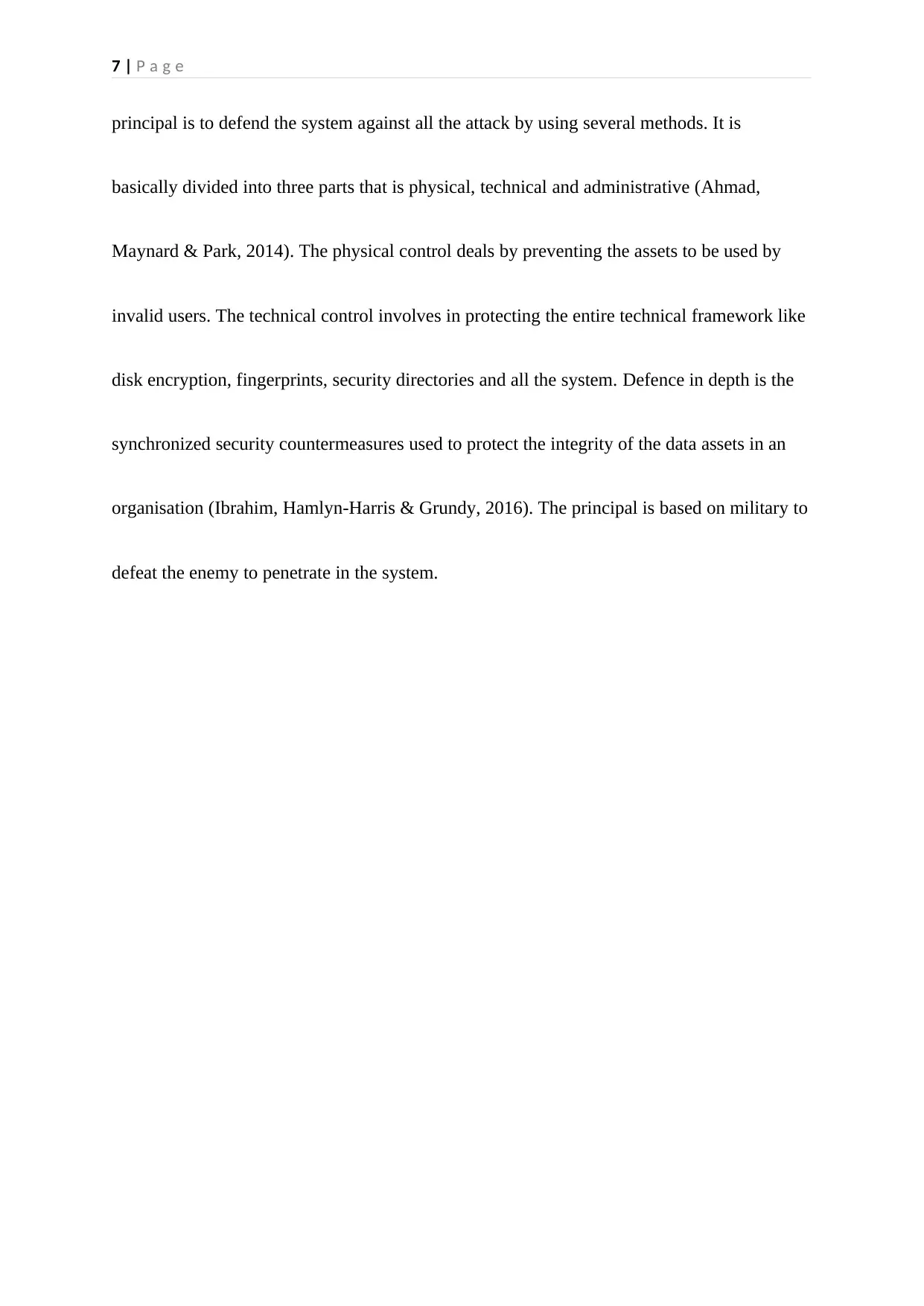
7 | P a g e
principal is to defend the system against all the attack by using several methods. It is
basically divided into three parts that is physical, technical and administrative (Ahmad,
Maynard & Park, 2014). The physical control deals by preventing the assets to be used by
invalid users. The technical control involves in protecting the entire technical framework like
disk encryption, fingerprints, security directories and all the system. Defence in depth is the
synchronized security countermeasures used to protect the integrity of the data assets in an
organisation (Ibrahim, Hamlyn-Harris & Grundy, 2016). The principal is based on military to
defeat the enemy to penetrate in the system.
principal is to defend the system against all the attack by using several methods. It is
basically divided into three parts that is physical, technical and administrative (Ahmad,
Maynard & Park, 2014). The physical control deals by preventing the assets to be used by
invalid users. The technical control involves in protecting the entire technical framework like
disk encryption, fingerprints, security directories and all the system. Defence in depth is the
synchronized security countermeasures used to protect the integrity of the data assets in an
organisation (Ibrahim, Hamlyn-Harris & Grundy, 2016). The principal is based on military to
defeat the enemy to penetrate in the system.
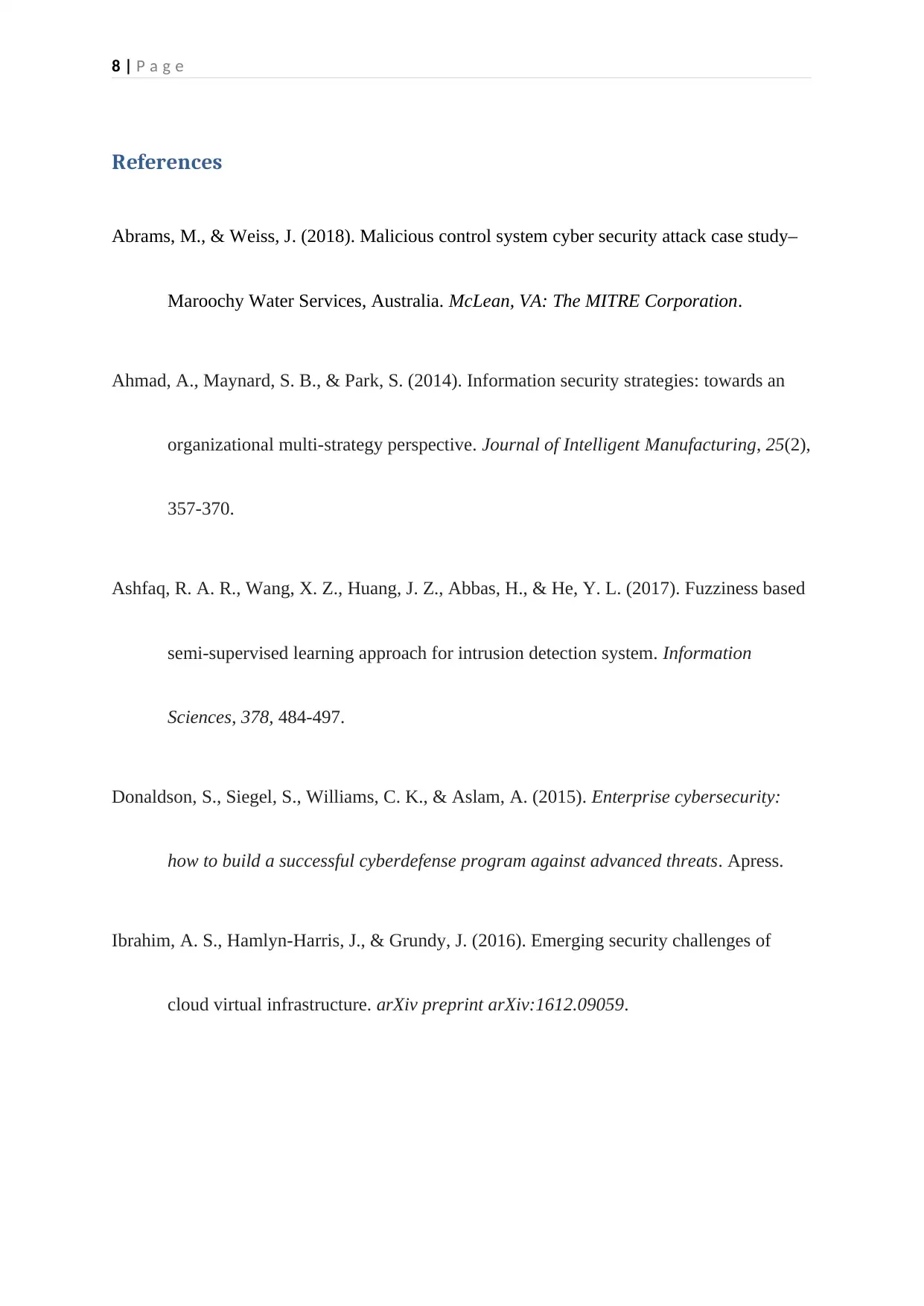
8 | P a g e
References
Abrams, M., & Weiss, J. (2018). Malicious control system cyber security attack case study–
Maroochy Water Services, Australia. McLean, VA: The MITRE Corporation.
Ahmad, A., Maynard, S. B., & Park, S. (2014). Information security strategies: towards an
organizational multi-strategy perspective. Journal of Intelligent Manufacturing, 25(2),
357-370.
Ashfaq, R. A. R., Wang, X. Z., Huang, J. Z., Abbas, H., & He, Y. L. (2017). Fuzziness based
semi-supervised learning approach for intrusion detection system. Information
Sciences, 378, 484-497.
Donaldson, S., Siegel, S., Williams, C. K., & Aslam, A. (2015). Enterprise cybersecurity:
how to build a successful cyberdefense program against advanced threats. Apress.
Ibrahim, A. S., Hamlyn-Harris, J., & Grundy, J. (2016). Emerging security challenges of
cloud virtual infrastructure. arXiv preprint arXiv:1612.09059.
References
Abrams, M., & Weiss, J. (2018). Malicious control system cyber security attack case study–
Maroochy Water Services, Australia. McLean, VA: The MITRE Corporation.
Ahmad, A., Maynard, S. B., & Park, S. (2014). Information security strategies: towards an
organizational multi-strategy perspective. Journal of Intelligent Manufacturing, 25(2),
357-370.
Ashfaq, R. A. R., Wang, X. Z., Huang, J. Z., Abbas, H., & He, Y. L. (2017). Fuzziness based
semi-supervised learning approach for intrusion detection system. Information
Sciences, 378, 484-497.
Donaldson, S., Siegel, S., Williams, C. K., & Aslam, A. (2015). Enterprise cybersecurity:
how to build a successful cyberdefense program against advanced threats. Apress.
Ibrahim, A. S., Hamlyn-Harris, J., & Grundy, J. (2016). Emerging security challenges of
cloud virtual infrastructure. arXiv preprint arXiv:1612.09059.
⊘ This is a preview!⊘
Do you want full access?
Subscribe today to unlock all pages.

Trusted by 1+ million students worldwide
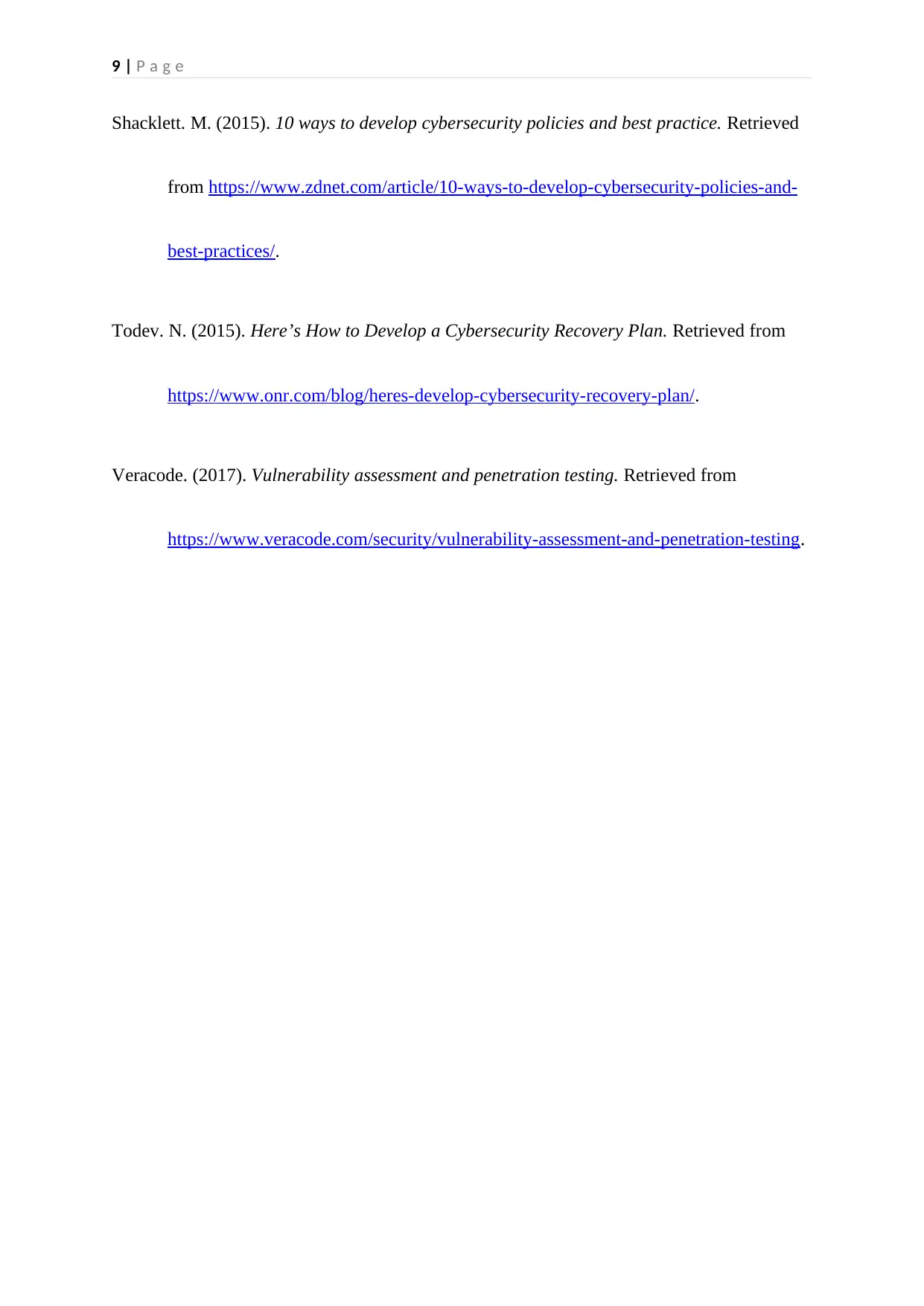
9 | P a g e
Shacklett. M. (2015). 10 ways to develop cybersecurity policies and best practice. Retrieved
from https://www.zdnet.com/article/10-ways-to-develop-cybersecurity-policies-and-
best-practices/.
Todev. N. (2015). Here’s How to Develop a Cybersecurity Recovery Plan. Retrieved from
https://www.onr.com/blog/heres-develop-cybersecurity-recovery-plan/.
Veracode. (2017). Vulnerability assessment and penetration testing. Retrieved from
https://www.veracode.com/security/vulnerability-assessment-and-penetration-testing.
Shacklett. M. (2015). 10 ways to develop cybersecurity policies and best practice. Retrieved
from https://www.zdnet.com/article/10-ways-to-develop-cybersecurity-policies-and-
best-practices/.
Todev. N. (2015). Here’s How to Develop a Cybersecurity Recovery Plan. Retrieved from
https://www.onr.com/blog/heres-develop-cybersecurity-recovery-plan/.
Veracode. (2017). Vulnerability assessment and penetration testing. Retrieved from
https://www.veracode.com/security/vulnerability-assessment-and-penetration-testing.
1 out of 10
Related Documents
Your All-in-One AI-Powered Toolkit for Academic Success.
+13062052269
info@desklib.com
Available 24*7 on WhatsApp / Email
![[object Object]](/_next/static/media/star-bottom.7253800d.svg)
Unlock your academic potential
Copyright © 2020–2025 A2Z Services. All Rights Reserved. Developed and managed by ZUCOL.





